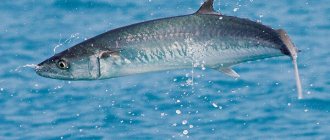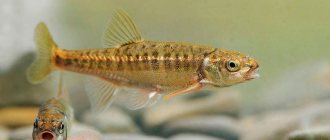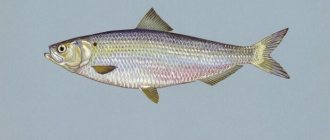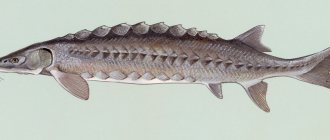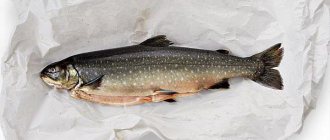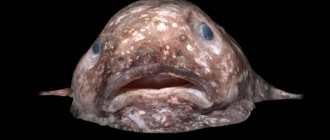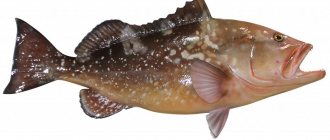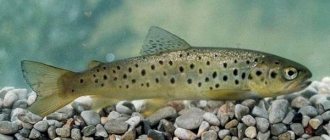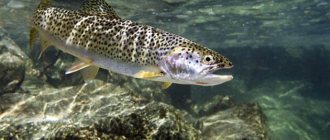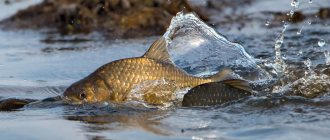Carp (Carassius) is a genus of freshwater fish of the carp family. The historical range was limited to fresh water bodies of Europe and northern Asia. As a result of human economic activity, it has expanded significantly: today populations of crucian carp can be found in rivers and lakes of the southern and eastern regions of Asia, North America, and northern Africa.
The first trophy of many experienced fishermen was crucian carp. Catching a small fish is relatively easy, but to catch a large trophy you need to know what crucian carp eats, where it lives and what its habits are.
What does crucian carp look like?
The taxonomy identifies several representatives of the genus with different external characteristics and behavioral features.
All existing varieties of crucian carp have several common characteristics:
- The body of the fish is round, the back is wide, the sides are slightly flattened.
- The dorsal fin is long and large.
- The eyes are small in size with dark pupils.
- The scales are smooth, dense, large.
- The fish has one row of pharyngeal teeth.
Types of crucian carp
In the currently accepted classification, the following species belong to the genus of freshwater crucian carp:
- Common crucian carp (in some sources the species is called round or golden crucian carp). Distinctive features are the rounded shape of the body, a relatively high dorsal fin, the color of the scales (the shade varies from copper to light golden), and a lighter color of the abdomen. This is the largest crucian carp of all freshwater species: the weight of adults can reach 3-4 kg, and the length is 50 cm.
- Silver crucian carp . It can be identified by its elongated body, transparent fins and large scales of a silvery hue. Silver crucian carp has average sizes: the length reaches 35-40 cm, and the maximum weight is 2-2.5 kg.
- Goldfish (or Chinese crucian carp). Decorative species intended for keeping in artificial reservoirs and aquariums. As a result of selection and hybridization, Chinese crucian carp, domesticated more than 10 centuries ago, is represented by a wide group of varieties that differ in size and appearance. The size of goldfish is from 2 to 30 cm, weight - no more than 300-350 grams.
- Japanese white carp . Has a light gray color. Distributed in Japan, Korea, found in reservoirs of the Far East.
Common crucian carp
Silver crucian carp
Chinese crucian carp
Japanese crucian carp
Experienced fishermen distinguish two more types of crucian carp based on their habitat:
- river crucian carp has a more elongated body and is covered with scales with a shiny surface;
- The body shape of crucian carp living in the lake is noticeably more massive, their scales are not so clean, and due to prolonged exposure to stagnant water, the meat may have an unpleasant taste and smell of mud.
The sea crucian family (or seabream) includes about 200 genera and species of fish that live in the warm waters of the Pacific, Atlantic and Indian oceans. The greatest interest for industrial fishing is dorado (red crucian carp), dentex, pagel, skup, and black sea crucian carp.
Differences between crucian carp and carp
Crucian carp and carp are biologically related species, and often both representatives of the family can be found both in natural conditions and when fishing in artificially stocked reservoirs. Without sufficient experience, it can be difficult to determine which fish is caught on the hook. At first glance, the external structure of crucian carp is no different from the structure of carp, however, upon closer examination of the trophy, you can see features characteristic of each species:
| Carp | crucian carp |
| There is a pair of mustaches near the mouth | No mustache |
| There is a noticeable hump at the top of the head | The head has a simplified shape |
| Body elongated and elongated | Body tall and flattened |
| There is a protrusion at the beginning of the dorsal fin crest | The contour of the dorsal fin is even |
| The scales are quite large and have a dark tint. | Scales are tougher and lighter |
| The spine is flexible, the fish can be easily bent | Body less flexible |
CARP
Option 2
Crucian carp fish lives in reservoirs located throughout Europe, with the exception of mountain rivers and lakes. It is also the easiest prey for fishermen and industrial fishing. Her most famous characteristic is laziness and clumsiness, she is somewhat clumsy and often crashes into various obstacles she encounters along the way.
There are three fairly well-known types of crucian carp:
- Golden crucian carp;
- Silver crucian carp;
- Gold fish.
Golden crucian carp are one of the largest, their length can be more than half a meter and their weight can reach three kilograms. The fish is covered with medium-sized scales that are golden in color, making it seem a little humpbacked, especially when it rises high up. In terms of external characteristics, it is compared to carp, but at the same time, golden crucian carp is thicker than carp. And the fins of the fish have an additional brown tint.
Silver crucian carp are distinguished by scales with a silver or slightly green tint. At the same time, it is several times smaller and lighter than golden carp. Its length is no more than 40 centimeters, and its weight does not exceed two kilos. It has an elongated muzzle, unlike the golden one, which has a flattened muzzle. Its back is smoother than that of gold.
Goldfish live only in aquariums and were specially bred by man so that at home there would be beauty in a small glass vessel. Previously, they were worth their weight in gold and were very expensive. Small fish become a decoration for any aquarium, and now they are not as expensive as in the distant past, so virtually every aquarium owner can afford them.
Habitats
Often crucian carp live in places where other fish simply cannot survive. They love to live in ponds and lakes that are overgrown with duckweed and have a sufficient amount of silt at the bottom. Small worms and bugs live there, which are the main food for any type of crucian carp. In such places he can find enough food and not worry about being hunted by large fish.
At the same time, in these places there are no other fish that do not hunt for crucian carp, which is slow and clumsy.
2, 3, 4, 7 grade
How many years does crucian carp live?
The lifespan of crucian carp depends on the habitat and species. For example, golden crucian carp, under favorable conditions, can live up to 12-15 years, and silver crucian carp - up to 10-12.
When determining age, measurements of body weight and length will only give an approximate result. Counting the annual rings on the scales will help to more accurately determine the lifespan of caught crucian carp.
Appearance
There are three types of crucian carp:
- gold;
- silver;
- gold fish.
The golden one is large, its length is more than half a meter, and it can even weigh more than three kilograms. Its scales are medium-sized, golden in color, its back rises high, the fish appears humpbacked. It is similar to carp, but thicker. The fins of this fish are brown with a golden tint.
The silverfish has silvery or greenish scales, and is smaller and lighter: up to 40 centimeters and up to two kilograms. Its muzzle is not round, like the golden one, but elongated, and the back is more even.
Goldfish are specially bred for aquariums. They are small and golden. Many people keep them at home for beauty. Goldfish do not require special care; they are quite unpretentious. They can also be seen in aquariums in shopping centers or other public places. In order for these fish to look the way they do now, they were kept in aquariums for a thousand years, selecting the most beautiful ones. In past times, goldfish were worth as much as real gold and were highly valued.
Crucian carp spawning
The readiness for reproduction in crucian carp occurs at the age of 3-4 years. The spawning period occurs in mid-May to early June. The optimal water temperature for spawning is +16-18 degrees.
When favorable conditions for reproduction occur, mature males and females gather in small schools and move to shallow waters with a lot of vegetation. When crucian carp spawn, adult slow-swimming individuals can be seen in coastal reeds, algae, and grass. Females spawn within 3-4 days. Most of the eggs stick to the stems and leaves of plants, the rest rise to the surface and serve as food for other inhabitants of the reservoir.
After 4-6 days, larvae up to 4 mm long emerge from the eggs. The first days they feed on the contents of the yolk sac, then they switch to plankton. By the end of summer, the fry reach a length of 5 cm.
Reproduction of crucian carp
Crucian carp spawns from 1 to 3 times a year. This is affected by the water temperature - it should be 17-18 degrees Celsius. This is approximately May-June, but dates may vary greatly. At this time, the crucian carp stops eating and catching it becomes a useless task. Females move closer to the shore where there are plants and spawn. One female can produce up to 200,000 eggs. Males are approximately 5 times smaller than females. In less than a week, embryos emerge from the eggs, which first feed on the yolk sac, and then move on to plankton and larger food.
- Goldfish - choice, main types, care, nutrition + 65 photos
In some reservoirs, only female goldfish live, which spawn with related fish. As a result, only females are born. This method of reproduction is called gynogenesis. On average, crucian carp live up to 12 years, becoming sexually mature at the age of 3-4 years.
If you liked this material, share it with your friends on social networks. Thank you!
- Encyclopedia
- Animals
- Fish Crucian
Crucian carp is a fish that lives in fresh water. The fish is oblong, round in shape, not large in size, with a wide back and high fins.
On average, fish can grow up to 25 cm and weigh up to 3 kg. There are specimens up to 60 cm long and weighing about 5 kg.
There are two main and frequently encountered types of crucian carp:
- Gold
- Silver
These types of crucian carp differ not in color, but in the shape of the head: the golden crucian has a flat head and is itself round, the silver crucian has a pointed head and a slightly oblong body.
In general, there are about 5 species of crucian carp in the world and many hybrids with similar characteristics and habitat.
Silver crucian carp lives about 9 years, golden carp - up to 12 years.
Where does crucian carp live?
The traditional habitat of crucian carp is swampy lakes and small ponds, ditches flooded with water, overgrown areas of rivers with a lot of vegetation and a muddy bottom. It does not need a high oxygen content, so it feels good even in turbid, polluted water with various suspensions.
In reservoirs with running water, crucian carp avoid places with intense currents, since due to the special shape of their body, it is quite difficult for them to move towards moving streams of water. The fish prefers to be near the very bottom, where it finds food and shelter in case of danger.
The crucian carp chooses areas with a thick layer of silt for one purpose: when there is a threat of drought or freezing of the reservoir, the fish buries itself in the sediment accumulated at the bottom and freezes, almost completely stopping its vital activity. This feature explains why crucian carp are so tenacious and continue to live and reproduce even in those reservoirs where other species of fish die.
Features of crucian carp fishing
When choosing a place for fishing, you should remember that crucian carp are not found in places with strong currents, clean sandy or rocky bottoms without sufficient vegetation. To catch a large trophy, you should choose a large lake or a deep river: in small ponds, the lack of natural predators leads to an uncontrolled increase in the population, as a result of which the fish do not have enough food for active growth.
When choosing a place and time for fishing, you should take into account the behavior of crucian carp at different times of the year. Active biting begins in the spring when the temperature in the reservoir rises to 10-12 degrees. For fishing, you should select shallow pools where the water has warmed up enough. After the end of spawning, fish activity resumes until the beginning of autumn. In the autumn months, crucian carp retreat to depths, where a comfortable temperature remains for some time.
In the winter months you can also go out for crucian carp, but it is difficult to predict the behavior of the fish. It all depends on the characteristics of the reservoir, weather conditions and some other factors. It is in winter that the chance of catching large crucian carp increases, as young individuals spend the winter buried in the silt, and older individuals periodically go out in search of food.
Crucian carp is sensitive to changes in atmospheric pressure, so you can count on a good bite only on sunny, windless days. The best time for fishing is morning and afternoon. During night fishing, the likelihood of catching large crucian carp increases, since adult individuals come out to feed in the late evening.
You can catch crucian carp using a float rod or feeder. When fishing with a fishing rod, choose places with a depth of 1-2 m near thickets of reeds or algae. The fishing spot can be fed with porridge made from cereals, oatmeal and semolina. Crucian carp is sensitive to odors, so a small amount of garlic, toasted sunflower cake or unrefined oil, and vanillin are added to the finished mixture.
Using feeder gear provides better results due to greater accuracy and casting range and the presence of feeders that attract fish to the fishing spot.
Dung worms, caddis flies, maggots, corn grains steamed for several hours, peas, and pearl barley are used as bait. For feeder feeders, it is better to prepare bait from specialized mixtures.
The crucian carp should be hooked sharply and immediately after the bite. Fishing specimens weighing up to a kilogram is not associated with difficulties, since they offer only minor resistance.
PERCH
Crucian carp in cooking
Lovers of crucian carp value it for its juicy meat with a characteristic sweetish taste. Fish is a source of Omega-3 and Omega-6 fatty acids, calcium, phosphorus, chromium, and vitamins. Fish fillet with low calorie content (only 86 kcal per 100 g) is very nutritious due to its high protein content. It is believed that crucian carp caught in early and mid-summer have the highest nutritional value.
Many people try not to eat crucian carp because of the large number of small bones in the upper part of the body. To prevent these bones from being felt while eating after frying, stewing or baking, you can do the following: make oblique cuts on both sides of the fish at a distance of 5 mm from each other. The carcass should be cut deeply, reaching with the knife to the spine. Crushed small bones after heat treatment are not felt and are not capable of injuring the oral cavity and esophagus.
Most often, crucian carp are fried, stewed with vegetables, and baked in sour cream. When baked in foil, the fish does not dry out and turns out very juicy and tender. Crucian carp is also suitable for pickling and salting.
PIKE
Interesting facts about crucian carp
- The largest crucian carp caught in Russia was caught in the Pskov region. The trophy weighed almost 5.5 kg.
- During the spawning of silver crucian carp, its eggs can be fertilized by other species of fish of the carp family. In this case, the nuclei of the egg and sperm do not merge, and the egg will contain only half the set of chromosomes, which will lead to the appearance of females. Due to this peculiarity of reproduction in some reservoirs, the number of females exceeds the number of males several times.
- The growth of fish depends on the amount of food in the reservoir. On average, crucian carp gains 150-200 grams per year.
- In the same place on different days and times of day, crucian carp can bite on completely different bait. When going fishing, you should take several types of bait with you.
Types of crucian carp
Golden crucian carp reaches a length of up to 50 cm. Weight can reach up to 4.5 kg in an adult. The color of the scales is golden and the color of the fins is dark brown. The paired pectoral and ventral fins may have a red tint.
Silver crucian carp grows up to 40 cm in length, and weight ranges up to 2 kg. This species of crucian carp has larger, silver-colored scales.
Goldfish is an artificially bred species of goldfish. This species was developed in China. These fish are domestic aquarium fish. There are many types of such fish. Therefore, their size can range from 2 to 45 cm, and also differ in color and body shape.
